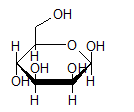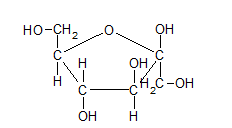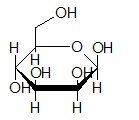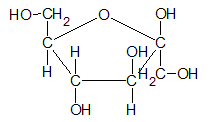
ALEKS 360 ACCESS CARD F/GEN. ORG.CHEM
3rd Edition
ISBN: 9781264452545
Author: SMITH
Publisher: MCG
expand_more
expand_more
format_list_bulleted
Concept explainers
Question
Chapter 24, Problem 24.32P
Interpretation Introduction
(a)
Interpretation:
The reason due to which an isomerase enzyme is used in the conversion of mannose-6-phosphate to fructose-6-phosphate needs to be explained.
Concept Introduction:
- Enzymes are biological catalysts that
speed up the reactions taking place within the cells. - Isomers are the compounds with same molecular formula but different arrangement of atoms.
- Mannose (C6H12O6) is −
- Fructose (C6H12O6) is −


Interpretation Introduction
(b)
Interpretation:
The type of isomers represented by mannose-6-phosphate and fructose-6-phosphate needs to be explained.
Concept Introduction:
- Enzymes are biological catalysts that speed up the reactions taking place within the cells.
- Isomers are the compounds with same molecular formula but different arrangement of atoms.
- Mannose (C6H12O6) is −
- Fructose (C6H12O6) is −


Expert Solution & Answer
Want to see the full answer?
Check out a sample textbook solution
Students have asked these similar questions
Identify and provide an explanation of the operational principles behind a Atomic Absorption Spectrometer (AAS). List the steps involved.
Instructions: Complete the questions in the space provided. Show all your work
1. You are trying to determine the rate law expression for a reaction that you are completing at 25°C. You measure
the initial reaction rate and the starting concentrations of the reactions for 4 trials.
BrO³¯ (aq) + 5Br¯ (aq) + 6H* (aq) → 3Br₂ (l) + 3H2O (l)
Initial rate
Trial
[BrO3]
[H*]
[Br]
(mol/L)
(mol/L) | (mol/L)
(mol/L.s)
1
0.10
0.10
0.10
8.0
2
0.20
0.10
0.10
16
3
0.10
0.20
0.10
16
4
0.10
0.10
0.20
32
a.
Based on the above data what is the rate law expression?
b. Solve for the value of k (make sure to include proper units)
2. The proposed reaction mechanism is as follows:
i.
ii.
BrО¸¯ (aq) + H+ (aq) → HBrO3 (aq)
HBrO³ (aq) + H* (aq) → H₂BrO3* (aq)
iii.
H₂BrO³* (aq) + Br¯ (aq) → Br₂O₂ (aq) + H2O (l)
[Fast]
[Medium]
[Slow]
iv.
Br₂O₂ (aq) + 4H*(aq) + 4Br(aq) → 3Br₂ (l) + H2O (l)
[Fast]
Evaluate the validity of this proposed reaction. Justify your answer.
е.
Д
CH3
D*, D20
Chapter 24 Solutions
ALEKS 360 ACCESS CARD F/GEN. ORG.CHEM
Ch. 24.2 - Analyze the following reaction by considering the...Ch. 24.2 - Prob. 24.2PCh. 24.3 - Prob. 24.3PCh. 24.3 - Prob. 24.4PCh. 24.3 - Prob. 24.5PCh. 24.3 - Prob. 24.6PCh. 24.3 - Prob. 24.7PCh. 24.3 - Prob. 24.8PCh. 24.4 - Prob. 24.9PCh. 24.4 - Prob. 24.10P
Ch. 24.4 - Prob. 24.11PCh. 24.5 - Prob. 24.12PCh. 24.5 - Prob. 24.13PCh. 24.5 - Prob. 24.14PCh. 24.6 - Prob. 24.15PCh. 24.7 - Prob. 24.16PCh. 24.7 - Prob. 24.17PCh. 24.7 - Prob. 24.18PCh. 24.7 - Prob. 24.19PCh. 24.7 - Use the number of molecules of ATP formed from the...Ch. 24.7 - Prob. 24.21PCh. 24.8 - Prob. 24.22PCh. 24.8 - Prob. 24.23PCh. 24.8 - Prob. 24.24PCh. 24.8 - Prob. 24.25PCh. 24.9 - Prob. 24.26PCh. 24.9 - Prob. 24.27PCh. 24.9 - Prob. 24.28PCh. 24 - Analyze each reaction by considering the...Ch. 24 - Analyze each reaction by considering the...Ch. 24 - Prob. 24.31PCh. 24 - Prob. 24.32PCh. 24 - Prob. 24.33PCh. 24 - Prob. 24.34PCh. 24 - Prob. 24.35PCh. 24 - Prob. 24.36PCh. 24 - Prob. 24.37PCh. 24 - Prob. 24.38PCh. 24 - Glucose is completely metabolized to six molecules...Ch. 24 - Why is glycolysis described as an anaerobic...Ch. 24 - Write the overall equation with key coenzymes for...Ch. 24 - Prob. 24.42PCh. 24 - Prob. 24.43PCh. 24 - Prob. 24.44PCh. 24 - Consider the aerobic and anaerobic avenues of...Ch. 24 - Prob. 24.46PCh. 24 - Prob. 24.47PCh. 24 - Prob. 24.48PCh. 24 - Prob. 24.49PCh. 24 - Prob. 24.50PCh. 24 - Prob. 24.51PCh. 24 - Prob. 24.52PCh. 24 - Prob. 24.53PCh. 24 - Prob. 24.54PCh. 24 - Prob. 24.55PCh. 24 - Prob. 24.56PCh. 24 - Prob. 24.57PCh. 24 - Prob. 24.58PCh. 24 - Prob. 24.59PCh. 24 - Prob. 24.60PCh. 24 - Prob. 24.61PCh. 24 - Prob. 24.62PCh. 24 - Prob. 24.63PCh. 24 - Prob. 24.64PCh. 24 - Prob. 24.65PCh. 24 - Prob. 24.66PCh. 24 - Prob. 24.67PCh. 24 - Fill in the boxes with the number of moles of each...Ch. 24 - Prob. 24.69PCh. 24 - Prob. 24.70PCh. 24 - Prob. 24.71PCh. 24 - Prob. 24.72PCh. 24 - Prob. 24.73PCh. 24 - Prob. 24.74PCh. 24 - Prob. 24.75PCh. 24 - Prob. 24.76PCh. 24 - What is the difference between ketogenic and...Ch. 24 - Prob. 24.78PCh. 24 - Prob. 24.79PCh. 24 - Draw the structure of the keto acid formed by the...Ch. 24 - Draw the products formed in each transamination...Ch. 24 - Prob. 24.82PCh. 24 - Prob. 24.83PCh. 24 - Prob. 24.84PCh. 24 - What metabolic intermediate is formed from the...Ch. 24 - What metabolic intermediate is formed from the...Ch. 24 - Prob. 24.87PCh. 24 - Prob. 24.88PCh. 24 - Prob. 24.89PCh. 24 - What is the cause of the pain and cramping in a...Ch. 24 - Prob. 24.91PCh. 24 - Prob. 24.92PCh. 24 - Prob. 24.93PCh. 24 - Prob. 24.94PCh. 24 - Prob. 24.95PCh. 24 - Prob. 24.96PCh. 24 - What type of enzyme would catalyze the conversion...Ch. 24 - Prob. 24.98PCh. 24 - Prob. 24.99CPCh. 24 - Prob. 24.100CPCh. 24 - Prob. 24.101CPCh. 24 - Prob. 24.102CP
Knowledge Booster
Learn more about
Need a deep-dive on the concept behind this application? Look no further. Learn more about this topic, chemistry and related others by exploring similar questions and additional content below.Similar questions
- H3C. H3C CH 3 CH 3 CH3 1. LDA 2. PhSeCl 3. H2O2arrow_forwardPlease predict the products for each of the following reactions: 1.03 2. H₂O NaNH, 1. n-BuLi 2. Mel A H₂ 10 9 0 H2SO4, H₂O HgSO4 Pd or Pt (catalyst) B 9 2 n-BuLi ♡ D2 (deuterium) Lindlar's Catalyst 1. NaNH2 2. EtBr Na, ND3 (deuterium) 2. H₂O2, NaOH 1. (Sia)2BH с Darrow_forwardin the scope of ontario SCH4U grade 12 course, please show ALL workarrow_forward
- Is the chemical reaction CuCl42-(green) + 4H2O <==> Cu(H2O)42+(blue) + 4Cl- exothermic or endothermic?arrow_forwardIf we react tetraethoxypropane with hydrazine, what is the product obtained (explain its formula). State the reason why the corresponding dialdehyde is not used.arrow_forwarddrawing, no aiarrow_forward
- If CH3COCH2CH(OCH3)2 (4,4-dimethoxy-2-butanone) and hydrazine react, two isomeric products are formed. State their structure and which will be the majority.arrow_forward+ Reset Provide the correct IUPAC name for the compound shown here. 4-methylhept-2-ene (Z)- (E)- 1-6-5-2-3-4- cyclo iso tert- sec- di tri hept hex oct meth eth pent ane yne ene ylarrow_forward+ Provide the correct IUPAC name for the compound shown here. Reset H3C H H C CH3 CH-CH3 1-3-methylpent ene trans- cis- 5-6-3-1-2-4- tert- tri sec- di cyclo iso but pent hex meth prop eth yl ane ene yne ☑arrow_forward
arrow_back_ios
SEE MORE QUESTIONS
arrow_forward_ios
Recommended textbooks for you
 Organic ChemistryChemistryISBN:9781305580350Author:William H. Brown, Brent L. Iverson, Eric Anslyn, Christopher S. FootePublisher:Cengage Learning
Organic ChemistryChemistryISBN:9781305580350Author:William H. Brown, Brent L. Iverson, Eric Anslyn, Christopher S. FootePublisher:Cengage Learning Introduction to General, Organic and BiochemistryChemistryISBN:9781285869759Author:Frederick A. Bettelheim, William H. Brown, Mary K. Campbell, Shawn O. Farrell, Omar TorresPublisher:Cengage Learning
Introduction to General, Organic and BiochemistryChemistryISBN:9781285869759Author:Frederick A. Bettelheim, William H. Brown, Mary K. Campbell, Shawn O. Farrell, Omar TorresPublisher:Cengage Learning

Organic Chemistry
Chemistry
ISBN:9781305580350
Author:William H. Brown, Brent L. Iverson, Eric Anslyn, Christopher S. Foote
Publisher:Cengage Learning

Introduction to General, Organic and Biochemistry
Chemistry
ISBN:9781285869759
Author:Frederick A. Bettelheim, William H. Brown, Mary K. Campbell, Shawn O. Farrell, Omar Torres
Publisher:Cengage Learning